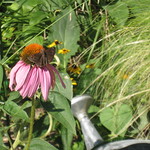 |
| male Funereal Duskywing, photo by Bill Bouton |
It's hard to imagine a more dramatic name than the Funereal Duskywing's (Erynnis funeralis). The name conjures up an image of a dreary black butterfly, possibly one whose preferred habitat is a graveyard.
But let's be fair. This little guy is certainly not as dark as, say, a black swallowtail or pipevine swallowtail.
Identifying the funereal is not as hard as identifying most Duskywing
butterflies. It's hind wing shows a white fringe that's absolutely
cheerful. No other butterfly in my area has this characteristic.
I managed to get a photo that was good enough for identification, though not as gorgeous as the above photo by Bill Bouton, who shared his through Creative Commons.
I had a Funereal in the backyard a few years ago, before I knew that it was a rare species for my area. In the world of birders and butterfliers, "rare" means excitement. My mood was anything but mournful when I spotted it this time. The range map in Jeffrey Glassberg's Butterflies through Binoculars: The East shows the nearest population in central Kansas--500 miles or so west of my yard in Saint Louis Missouri. In Butterflies of North America, Kenn Kaufman and Jim Brock show it as uncommon as close as Rolla, MO--less than 100 miles from me.
I looked it up on Butterflies and Moths of North America. They include a map of reports, which showed a sighting as far north as the Illinois Wisconsin border. I decided to submit my report also. Their process is a little more rigorous and some citizen science websites. I'll go through the steps.
Step 1: In the menu of the website, click on "get involved."
Step 2: Get a free account with Butterflies and Moths of North America (BAMONA for short).
Step 3: Fill out the submission form online. You'll need to submit a photo of your butterfly or moth, and the photo needs to be cropped so that the insect fills the frame.
Stay with me here. This photo editing could be an obstacle but it doesn't need to be. I used to edit my photos on the photo-sharing website Flickr, with a free website/tool called Picnik. Picnik is no longer partnered with Flickr. They moved to Google+. Editing is still available on Flickr however, in a new tool called Aviary. Just use the action menu on the Flickr photo you want to edit. Of course you can also crop your photos with iPhoto or Google's Picasa--which looks a lot like Picnik. But wait! There's more. BAMONA also would like you to add your user name as a "watermark" to your photo. That's a lot easier than it sounds. Just use the text tool in the editing program you're using. Mine looked like this when I finished editing.
To complete the report you'll need to indicate on the map where the butterfly was seen. Just enter the address in the address box then check to see that the point on the map goes just where you want it. Finish by adding the state and county where you saw the butterfly or moth.
Step 4: Wait anxiously for a reply from an expert in your region. The expert hopefully will confirm your report. My region's expert turned out to be a friend of mine, the chair of the entomology group of Webster Groves Nature Study Society.
Optional step 5: Send an email offering to let them use your photo on the website. The full instructions are on BAMONA.
My thanks to you for staying with my blog. Now that I've cleared up the spam that led to my site being listed as "suspicious," I thought I'd better get cracking and write a post!
You might also like:
 |
| Emma Peel as a Butterfly |
 |
| Of Cabbages & Checkered Whites |

Thanks for this advice. I am just starting to learn butterflies
ReplyDelete.i haven't yet registered with that website.
Butterflies are a lot of fun. I'm still learning too but I concentrate on the big gorgeous ones!
ReplyDeleteGlad to see you back Anne! With a rare butterfly sighting, I'd be interested to know what plant you saw the insect visiting.
ReplyDeleteIt's good to be back, Alan! The butterfly was nectaring on bottlebrush buckeye (Aesculus parviflora), a favorite of butterflies & hummingbirds & gardeners.
ReplyDeleteWelcome back Anne! Nice butterfly, it is really gorgeous and huge! Very nice shots!
ReplyDeleteThanks, Niceartlife! I wish I had taken that first shot.
DeleteOne day you will Anne, it is difficult to combine all aspects and a butterfly who sits still in the perfect moment.
DeleteLove the pics! great blog ... adding to favourites immediately. Thanks for the awesome pics too.
ReplyDeletePaul
Thanks Paul! Appreciate the visit from the land down under!
ReplyDelete